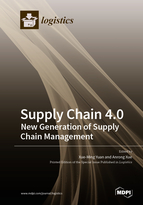Supply Chain 4.0: New Generation of Supply Chain Management
A special issue of Logistics (ISSN 2305-6290).
Deadline for manuscript submissions: closed (28 May 2022) | Viewed by 68181
Special Issue Editors
Interests: data science; predictive and prescriptive analytics; supply chain analytics; logistics and supply chain management; stochastic models, algorithms and optimization
Special Issues, Collections and Topics in MDPI journals
Special Issue Information
Dear Colleagues,
The world is experiencing Industry 4.0, the fourth industrial revolution. The industrial revolution began in the early years of this millennium with autonomous production using cyber-physical systems (CPS), cloud computing, Internet of things (IoT), Internet of services (IoS), and augmented reality. Since then, Industry 4.0 has greatly influenced daily life in every aspect, from shopping to dining, from working to entertaining, etc. It is changing people’s lifestyles and living behaviors, and even thinking and mindsets. Industry 4.0 has had a revolutionary impact on supply chain management. In the environment of Industry 4.0, suppliers are intelligent, factories are smart, products are smart, and customers demand all-around greater satisfaction from services. This digitization enables the integration of processes and systems across companies and industrial sectors, and creates new business models and value generation opportunities. Enterprises and businesses are digitalized, profitable, and sustainable. Manufacturing systems and services are real-time capable, interoperable, modular, decentralized, virtualized, and service-oriented. Supply Chains are fully visible, connected, and integrated. With the rapid growth of Industry 4.0 technologies, supply chain management is being transformed into a new generation, Supply Chain 4.0.
Supply Chain 4.0 refers to the supply chain operating in the environment of Industry 4.0, which is designed, planned, managed, and optimized using Industry 4.0 technologies to maximize customer satisfaction with minimal operational cost and minimal environmental impact. The distinguishing attributes of Supply Chain 4.0 include visibility, connectivity, coordination, synchronization, autonomy, resilience, sustainability, and optimality. There are many research issues and challenges associated with Supply Chain 4.0, for example, how to leverage real-time market intelligence to model customer behaviors and more accurately predict future customer demand? How to base on Data Analytics to stock minimal inventory to maximize customer service level? How to apply artificial intelligence and machine learning to allocate production capacity, schedule job orders, and plan equipment maintenance to minimize the disruption of production lines? How to utilize Industry 4.0 technologies to select the right supplier for the right material at the right time? How to tap into blockchain technology to share the data and essential information among the parties across a supply chain? How to collaborate and coordinate the operations of supply chain partners in the environment of Industry 4.0? This Special Issue calls for accomplishments and contributions from academia and industry to address Supply Chain 4.0 issues and challenges. Original papers on, but not limited to, the following topics are welcome:
- Additive manufacturing supply chain management
- Autonomous warehouse systems
- Big data analytics
- Collaborative supply chain management
- Consumer behavior modeling and prediction
- Data-driven sales & operations planning (S&OP)
- Data-driven SCOR models
- Digital supply chain management
- End to end supply chain integration
- Intelligent demand forecasting
- Intelligent manufacturing systems
- Intelligent transportation systems
- Inventory track and trace
- Predictive maintenance systems
- Predictive inventory management and optimization
- Real-time supply chain synchronization and coordination
- Resilient supply chain management
- Smart products
- Smart factories
- Supplier selection intelligence
- Supply chain analytics
- Supply chain optimization
- Supply chain visibility and connectivity
- Sustainable supply chain management
Dr. Xue-Ming Yuan
Prof. Dr. Anrong Xue
Guest Editors
Manuscript Submission Information
Manuscripts should be submitted online at www.mdpi.com by registering and logging in to this website. Once you are registered, click here to go to the submission form. Manuscripts can be submitted until the deadline. All submissions that pass pre-check are peer-reviewed. Accepted papers will be published continuously in the journal (as soon as accepted) and will be listed together on the special issue website. Research articles, review articles as well as short communications are invited. For planned papers, a title and short abstract (about 100 words) can be sent to the Editorial Office for announcement on this website.
Submitted manuscripts should not have been published previously, nor be under consideration for publication elsewhere (except conference proceedings papers). All manuscripts are thoroughly refereed through a single-blind peer-review process. A guide for authors and other relevant information for submission of manuscripts is available on the Instructions for Authors page. Logistics is an international peer-reviewed open access quarterly journal published by MDPI.
Please visit the Instructions for Authors page before submitting a manuscript. The Article Processing Charge (APC) for publication in this open access journal is 1400 CHF (Swiss Francs). Submitted papers should be well formatted and use good English. Authors may use MDPI's English editing service prior to publication or during author revisions.
Keywords
- Industry 4.0
- supply chain management and optimization
- Supply Chain 4.0
- supply chain analytics
- supply chain visibility and connectivity
- supply chain synchronization and coordination







